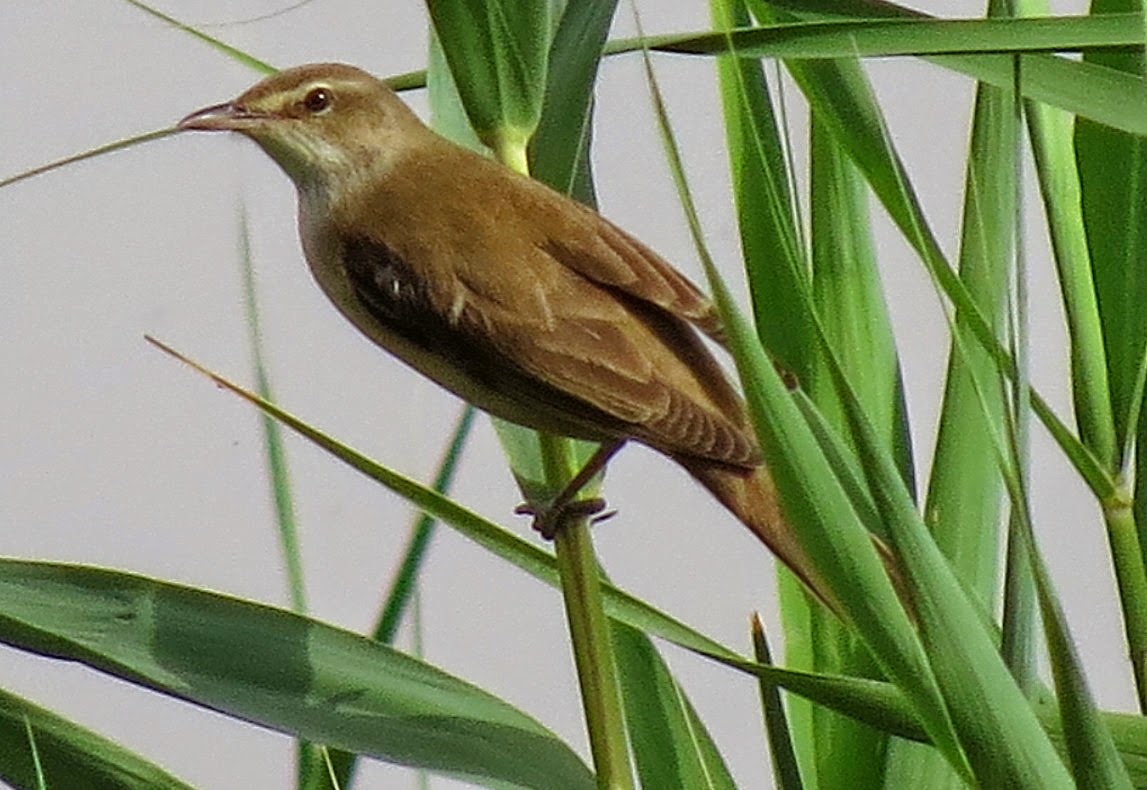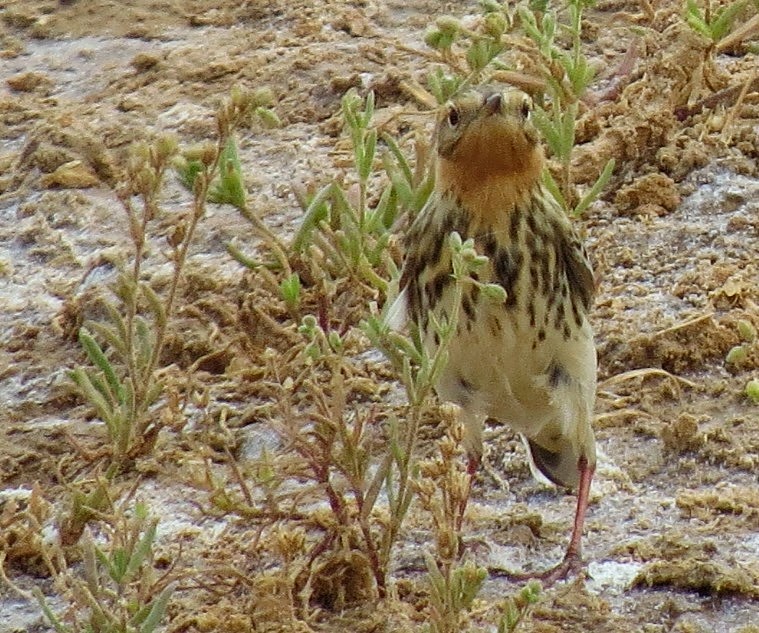water rail
In the meantime I'll recount the birding session in chronological order.
male red-backed shrike
On arrival, I decided to do a clockwise circuit round the wetland as usual. This means starting in an area which has plenty of tamarisk bushes.
Straight away it was obvious that there was a major wave of red-backed shrike on their way through. I counted five shrikes in these bushes.
Spanish sparrow
This part of the circuit is one of two areas with large numbers of house sparrow. However on Saturday I noticed quite a few Spanish sparrow there too.
barred warbler
little stint
As you go round, there is an area where water spills out from the reeds and grass giving the appearance in places of a stream. Small groups of little stint were seen here.
female red backed shrike
In the bushes and reeds were still more red backed shrike of both gender. In the reeds Eurasian reed warbler made fleeting appearances.
After an hours walk, at seven in the morning, I arrived close to a place one week before where I had flushed a bird back into the under-growth. At the time I instinctively felt wasn't a moorhen but I didn't get more than a fraction of a second's look.
This time, I approached slowly and from within cover I scanned the place I had seen it. I couldn't believe my luck. A water rail was standing there. Indeed it walked around for two or three minutes without noticing me.
Within Saudi Arabia, I have only seen them in Tabuk before.
water rail
Eventually it went into cover and I moved on. Less than 50 metres further round but closer to the impenetrable centre of the wetland there was some interesting activity in the reeds. Two great reed warbler showed themselves and a sedge warbler popped up.
great reed warbler
I think the sedge warbler may have been pursued by the great reed warblers.
second great reed warbler
After that flurry of excitement I continued walking round but very slowly. I noticed crested lark and Kentish plover to my left and away from the wetland.
crested lark
There was persistent squealing noise like a puppy begging. Indeed I thought it was just that. It wouldn't have been the first time for me in Saudi Arabia to come across wild puppies.
I scanned the edge of the reeds. It turned out to be a second water rail calling in an area at least 200 metres from the first.
a second water rail
This one never fully came out of the reeds but was in view for at least two minutes.
curlew sandpiper with little stint
The next area on the way round has lots of open but shallow water. Every time I have visited it has had some waders. This time there were curlew sandpiper and twice that number of little stint. There was a single common snipe with them too.
purple heron
I have to move away from the main wetland in this area and walk behind some earth works to be able to get close to the waders without scaring them off. Next to the earth works are some pools with reeds. As I walked past one I accidentally flushed a resting purple heron.
two willow warbler
Once I passed the open water area, I moved back in towards the reed beds. There are several low bushes in this stretch. I saw several willow warbler and another barred warbler.
whinchat
Slightly further round, the main birds of note, also out near the bushes rather than by the reeds, were a whinchat and a spotted flycatcher.
spotted flycatcher
The wetland slopes very gently down from south to north. In the northern section there is some deeper water. It rained last week so the water levels were higher so other parts of the northern section have flooded. These parts were teeming with yellow wagtail from five different sub species on Saturday.
lutea yellow wagtail
In the deeper water areas I once again saw moorhen, little grebe and little bittern.
male little grebe
Black winged stilt were common in many parts of this northern section.
black winged stilt
The overflow in the north creates a short stream which was longer than usual because of the rain. Where it breaks out of the wetland is very green and has proven good for birds on every visit.
squacco heron
This time as well as more yellow wagtail, there were two squacco heron, twenty or so red-throated pipit and several wood sandpiper.
red throated pipit
I usually find the part of the circuit where I head back south towards the start is not such good birding. It certainly has a higher percentage of blanket reed beds than elsewhere. However I suspect an important reason is that I am always there at hotter times of day when bird activity has reduced.
Daurian shrike
Two observations of note here included a Daurian shrike which was the only one of the day.
wood sandpiper
I also managed to finally get a good view and photo of one of the wood sandpiper around.
Overall I was very satisfied with this birding session. I rank it within the top ten sessions I have had in the Riyadh area.
The wetland has some advantages over Al Hayer. There is less human disturbance and cars can't get near because they would simply get bogged down. Of course this means all birding has to be done on foot but this is my favoured approach anyway.
The full list of species seen at East Salbukh:
Little grebe
|
Turkestan shrike
|
Little bittern
|
Red backed shrike
|
Squacco heron
|
Crested lark
|
Purple heron
|
Barn swallow
|
Water rail
|
Graceful prinia
|
Moorhen
|
Great reed warbler
|
Little ringed plover
|
Eurasian reed warbler
|
Kentish plover
|
Sedge warbler
|
Common snipe
|
Willow warbler
|
Green sandpiper
|
Barred warbler
|
Wood sandpiper
|
Black bush robin
|
Little stint
|
Whinchat
|
Curlew sandpiper
|
Spotted flycatcher
|
Collared dove
|
House sparrow
|
Laughing dove
|
Spanish sparrow
|
Common swift
|
Yellow wagtail
|
Daurian shrike
|
Red throated pipit
|
























Beautiful series of photos!
ReplyDeleteThank you Linda. It was a wonderful day. Rob
Delete